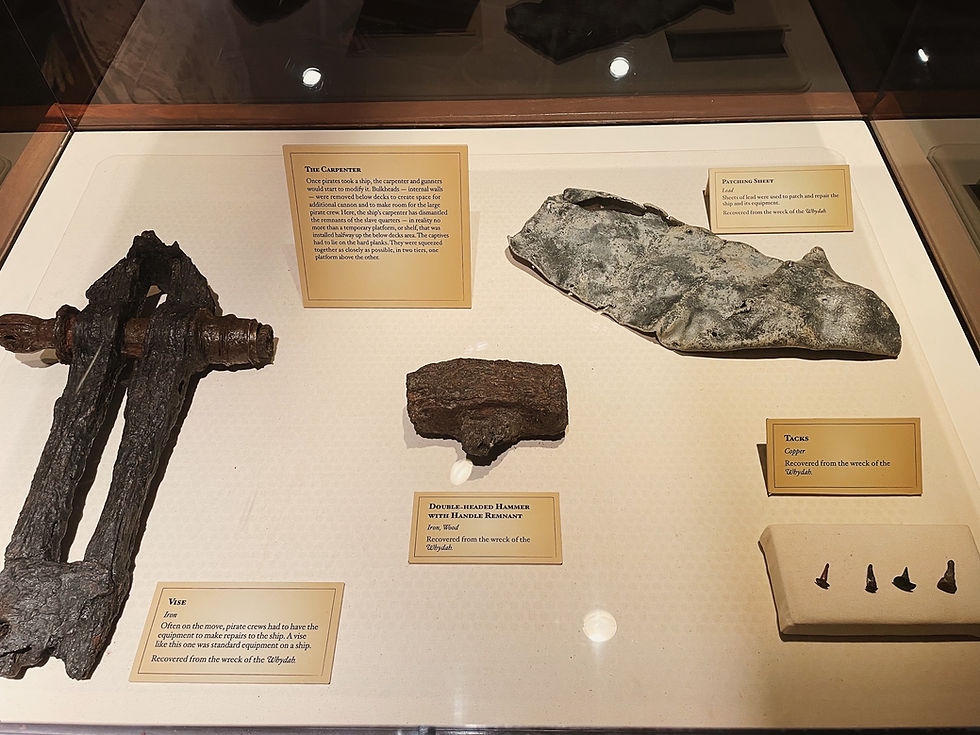Some Nineteenth-Century Notables
- marcsitkin
- Nov 18, 2021
- 4 min read
Updated: May 14, 2023

Figure 1. Advertisement for Boynton’s Patent Lightning Saws, 1878.
Excerpted from The Chronicle Vol. 63 no. 2, June 20
by Patty MacLeish
EAIA member Charlie Beatty found these advertisements in a 1878 catalog and sent them along to share. The first is for Boynton’s Patent Lightning Saws (Figure 1). Some short entries about Boynton saws have previously been published in The Chronicle (44, no. 3 <1991>: 85; 47, no. 4 <1994>:104; and 59, no. 1<2006>:19), and there is much more to be learned from Boynton’s own catalog for his “Improved Patent Lightning Saws,” which is available from EAIA member Gary Roberts in the “Free Stuff” section of his Web site, Toolemera.com. Gary describes the catalog as “A delightful little catalog by the celebrated E. M. Boynton, skewering Disston and all comers as to their claims regarding saws in general, and addressing the clear superiority of the Patented Lightening Saw.”
In this advertisement Boynton repeats his challenge to other sawmakers that he made in his catalog:
No other manufacturer has yet ventured to put his Saws in competition with it at the American Institute or elsewhere, and the challenge of $500 for a public trial has never been accepted. It is needless, therefore, to speak of the merits of defects of the various saws now on the market.
The saws gained notice in England in the Report on the Philadelphia International Exhibition of 1876 by Charles Henry Gordon-Lennox Richmond (6th Duke of) and Sir Herbert Bruce Sandford. The authors noted:
Mr. Eben Moody, Boynton, New York, exhibits a good selection of saws of cross-cut and other variety of considerable extent; they are made out of the best cast-steel, and well finished; also ice and dray saws. The speciality of this exhibit was a cross-cut saw, which is named “the Patent Lightning Saw,” from its performances. Its novelty is in the shape of the teeth, which are different from those of an ordinary cross-cut saw.
By the form of the teeth the saw can cut both by the forward and backward motion. An experiment was made in the presence of two officials of the effect of this form of teeth, when two men cut through a 16 in. log in 17 seconds.
This firm also shows a new form of pruning saws with cutting teeth on both Pruning saws edges; they are made from 14 to 22 inches long, and are said to be much more convenient than the common form.
One wonders what Boynton would have thought of the comment about the selection only being “good.”
The advertisement for Thorne, De Haven & Co. includes an illustration (Figure 2)that appears to be of the drill described in under “Items and Novelties” in the Journal of the Franklin Institute (LXV, no. 1:147):

Figure 2. Advertisement for Thorne, De Haven & Co., 1878.
Improved Radial Drilling Machine.—The advantages of the radial drilling machine over the ordinary drill press, are becoming more fully understood and appreciated, and in the best machines hop practice, it is acknowledged to be preferable to use the former on all work, no matter how small, while on work of any size, or which has several holes to be drilled in it, there is no question as to its great superiority. Heretofore, these machines have been used almost exclusively {or drilling large work on the floor, and have not been adapted to work usually done on the ordinary drill press. Messrs. Thorne, De Haven & Co., of this city, have designed and are manufacturing a drilling machine, which possesses all the features of the most approved stationary machines, combined with the advantages of the radial machine.
The counter-shaft is on the baseplate, and the driving cone-pulley and back-gearing on top of the post, thus placing the belt-shifter in a convenient position, and enabling the changes of speed to be made quickly. The bevel-gearing on top of the post permits the arm to rotate through an arc of 320 degrees, or eight-ninths of a revolution. The cone has four steps, which, with the back-gearing, gives eight changes of speed. The table has T slots on top and side, and is raised and lowered on the post by a rack and pinion, operated by a tangent-wheel and worm. This enables the top of the piece to be kept at the same height. When the work is too high to go on the table at its lowest position, the base-plate which projects from the front of the machine can be used. The table being gibbed to the post, reduces the leverage, and makes a much stronger and stiffer arrangement than where it is set on a base-plate to depend for stiffness on a thin section of metal. The saddle carrying the spindle is travelled in and out on the arm by a rack and pinion operated by a handwheel in a convenient position. The spindle is counterbalanced by a weight, which is carried by the saddle—this being the only Radial Drill in the world which has this feature. As the counter-weight takes directly on the spindle, it prevents the latter from dropping, in event of any lost motion. This overcomes a fruitful cause of breaking drill ; namely, when the drill drops into a blow-hole, or through a drilled hole before it is finished. The feed is obtained by a rack and pinion, operated by a worm and tangent-wheel—thus reducing the lost motion to a minimum. The self-acting feed has three speeds, and is connected and disconnected by a friction-clutch, operated in the centre of the hand-wheel. The hand-feed is quick, to enable the spindle to be run up speedily.




Comments